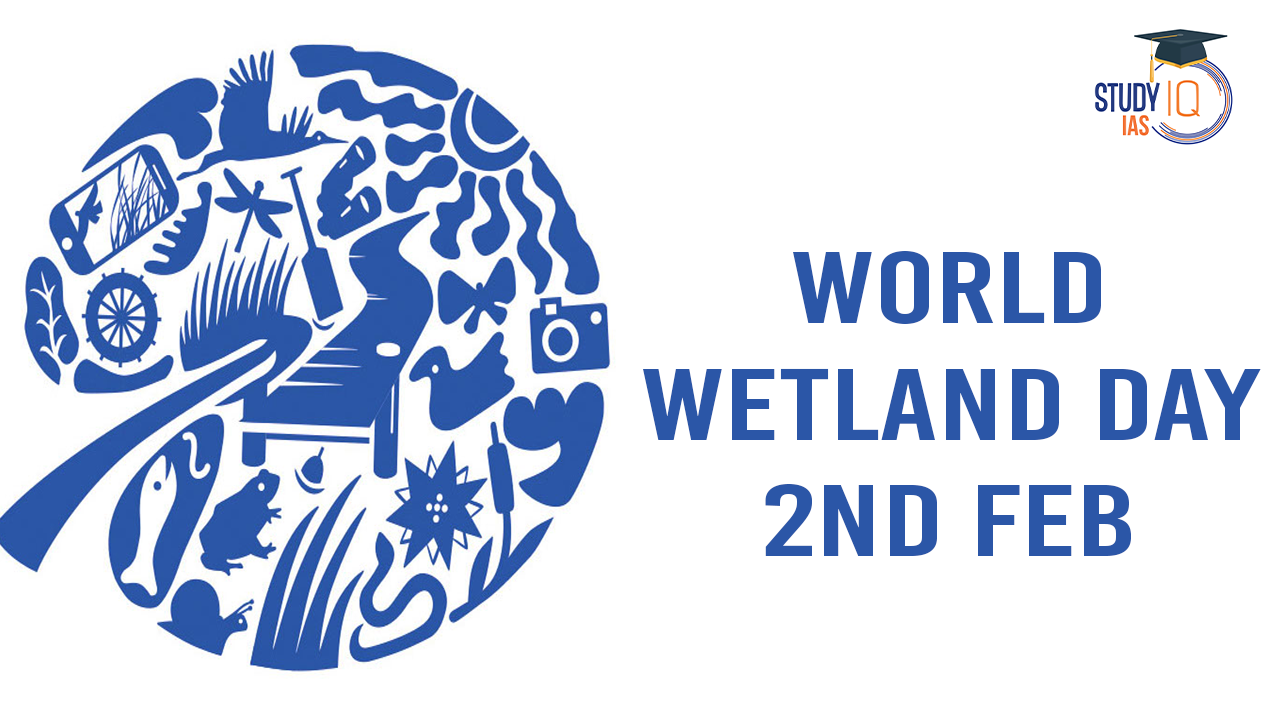Table of Contents
World Wetlands Day is celebrated every year on 2nd February to highlight the importance of wetlands in maintaining biodiversity, regulating climate, and providing various ecosystem services. On the same day, it commemorates the adoption of the Ramsar Convention on Wetlands on 2nd February 1971.
World Wetlands Day 2025
The Union Ministry of Environment, Forest and Climate Change (MoEFCC) organized the World Wetlands Day 2025 celebrations at the Parvati Arga Ramsar Site, Gonda, Uttar Pradesh (UP) on 2nd February 2025.
| World Wetlands Day 2025 Overview | |
|---|---|
| Event Name | World Wetlands Day 2025 |
| Date | 2 February 2025 |
| Theme | Protecting Wetlands for Our Common Future |
| Objective | To raise global awareness about the importance of wetlands for biodiversity, climate resilience, and human well-being. |
| Established By | Ramsar Convention (First celebrated in 1997) |
| Importance | Wetlands provide water purification, flood control, carbon storage, and habitat for wildlife. |
| Global Observance | Organized by governments, environmental organizations, and communities worldwide through campaigns, educational programs, and conservation efforts. |
| Major Supporting Organizations | Ramsar Convention, UNESCO, WWF, UNEP, and local environmental bodies. |
| Key Locations Highlighted | Mont-Saint-Michel (France), Wood Buffalo National Park (Canada), Banc d’Arguin National Park (Mauritania), Itsukushima Shinto Shrine (Japan), and Victoria Falls (Zimbabwe/Zambia). |
| Threats to Wetlands | Climate change, pollution, deforestation, urbanization, and unsustainable agricultural practices. |
| Conservation Efforts | Wetland restoration projects, Ramsar site designations, eco-tourism initiatives, and sustainable development policies. |
| Related International Event | COP15 of the Ramsar Convention (July 2025, Victoria Falls, Zimbabwe) |
History of World Wetlands Day – Timeline
An annual celebration of World Wetlands Day is on February 2, aimed at raising. This day aims to raise global awareness of wetlands’ crucial role in maintaining biodiversity, regulating climate, and supporting human livelihoods. The day commemorates the adoption of the Ramsar Convention on Wetlands on February 2, 1971, in the Iranian city of Ramsar.
| Year | Event |
|---|---|
| 1971 | The Ramsar Convention on Wetlands was adopted on February 2 in Ramsar, Iran, to promote wetland conservation and sustainable use. |
| 1996 | The 19th Meeting of the Ramsar Convention’s Standing Committee decided to observe World Wetlands Day annually on February 2. |
| 1997 | First celebration of World Wetlands Day, with events organized worldwide to raise awareness about wetland conservation. |
| 2001 | The Ramsar Wetland Conservation Awards were introduced to recognize outstanding contributions to wetland protection. |
| 2015 | The United Nations acknowledged World Wetlands Day as an important global awareness day for wetland conservation. |
| 2021 | 50th anniversary of the Ramsar Convention was celebrated with renewed commitments to wetland preservation. |
| 2022 | The United Nations General Assembly officially adopted a resolution recognizing February 2 as World Wetlands Day and urged global action for wetland conservation. |
World Wetlands Day 2025: Theme & Celebrations
Theme: Protecting Wetlands for Our Common Future
This year’s theme underscores the urgent need to conserve and restore wetlands for future generations. It also aligns with the 15th Meeting of the Conference of the Contracting Parties to the Convention on Wetlands (COP15), scheduled for July 2025 in Mosi-oa-Tunya/Victoria Falls, Zimbabwe.
Global Events and Activities
World Wetlands Day 2025 will be celebrated worldwide with various activities, including:
- Educational Campaigns: Schools, colleges, and universities will conduct workshops, webinars, and awareness drives.
- Community Participation: Wetland clean-up drives, plantation programs, and eco-tours.
- Policy Dialogues: Government agencies and environmental organizations will discuss policies for wetland conservation.
- Social Media Awareness: Hashtags like #WorldWetlandsDay, #ProtectWetlands, and #WetlandsForFuture will trend globally.
- Recognition of Wetland Champions: Organizations and individuals working for wetland conservation will be honored.
Iconic Wetlands Around the World
| Wetland | Location | Significance |
|---|---|---|
| Mont-Saint-Michel and its Bay | France | Ramsar & UNESCO site; supports migratory birds and fisheries; features a Gothic-style Benedictine abbey. |
| Wood Buffalo National Park | Canada | Home to one of the world’s largest inland deltas; provides fresh water and food security for Indigenous communities. |
| Banc d’Arguin National Park | Mauritania | Vital coastal wetland; supports fish stocks and migratory birds; sustains local fishing communities. |
| Itsukushima Shinto Shrine | Japan | Cultural and ecological site; protected wetlands enhance tourism and preserve spiritual heritage. |
| Sundarbans Mangrove Forest | India & Bangladesh | Largest mangrove forest; crucial for tiger conservation and coastal protection. |
| Kakadu National Park | Australia | UNESCO World Heritage site; rich in biodiversity; home to indigenous rock art and wetlands. |
| Everglades National Park | USA | Largest tropical wetland in the U.S.; crucial for water filtration and endangered species. |
| Okavango Delta | Botswana | A vast inland delta; rich in wildlife, supporting elephants, lions, and hippos. |
| Pantanal Wetlands | Brazil, Bolivia, Paraguay | Largest tropical wetland; a biodiversity hotspot with diverse aquatic and terrestrial species. |
| Danube Delta | Romania & Ukraine | Europe’s largest wetland; supports rare birds and freshwater fish species. |
Importance of Wetlands
Wetlands are one of the most productive ecosystems on Earth, offering numerous environmental, economic, and social benefits:
- Biodiversity Hotspots: Home to a variety of flora and fauna, including migratory birds, amphibians, and aquatic species.
- Climate Change Mitigation: Wetlands act as carbon sinks, reducing greenhouse gas emissions.
- Water Purification: Natural filtration systems that remove pollutants from water bodies.
- Flood Control: Absorb excess water during heavy rains and prevent soil erosion.
- Livelihood Support: Provide resources such as fish, timber, and medicinal plants for millions of people worldwide.
- Cultural and Spiritual Significance: Many wetlands have been integral to indigenous cultures and traditions.
Wetlands Under Threat
Despite their ecological significance, wetlands are among the most threatened ecosystems in the world. Over 35% of wetlands have been lost since 1970 due to urbanization, pollution, deforestation, and climate change. Protecting wetlands is crucial for sustaining biodiversity, human livelihoods, and climate resilience.
Significance of World Wetlands Day
- Conservation Awareness: It raises awareness of the importance of wetlands in biodiversity, water security, and climate change mitigation.
- Sustainable Development: Responsible policies and actions are encouraged to prevent the degradation of wetlands.
- Community Involvement: Governments, NGOs, and local communities have been involved in wetland restoration projects, education programs, and policy advocacy.
Conclusion
World Wetlands Day 2025 reminds us of the importance of wetlands in building a sustainable future. The theme, “Protecting Wetlands for Our Common Future,” calls for immediate action in protectingto protect these critical ecosystems. It is through involvement in conservation that we canConservation is the only way to continue to ensureensuring wetlands thrive, supporting biodiversity, climate stability, and human well-being.


 Governor's Assent to State Laws and Bill...
Governor's Assent to State Laws and Bill...
 Central Pollution Control Board (CPCB) R...
Central Pollution Control Board (CPCB) R...
 Kancha Gachibowli Forest (KGF), Signific...
Kancha Gachibowli Forest (KGF), Signific...





















